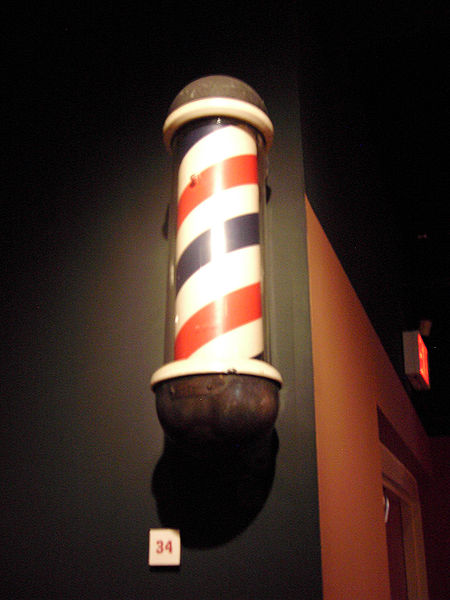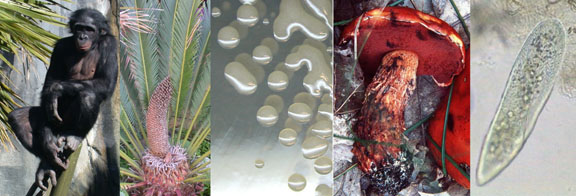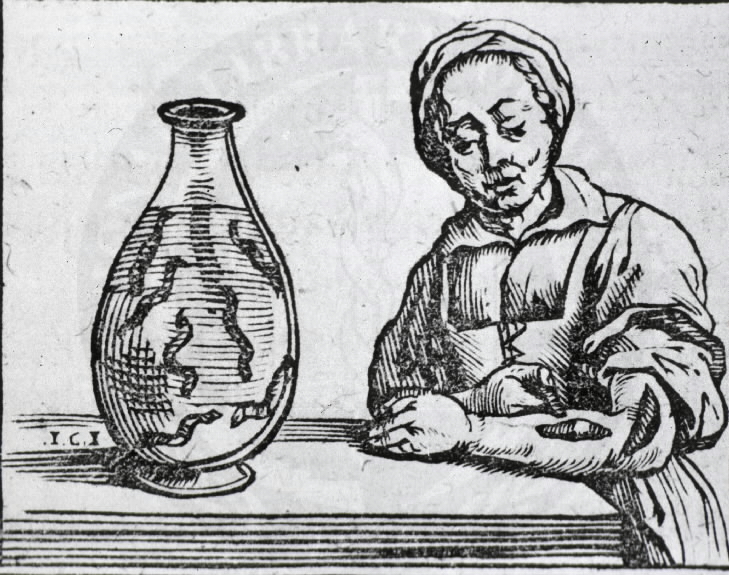Bloodletting:
An Ancient Practice
The use of leeches in therapy dates back thousands of years to some of the first human civilizations. Paintings depicting the use of leeches have been found on some ancient Egyptian walls, approximately dated around 1567-1308 B.C. During the first few centuries AD, the leech was being used in parts of China and in Rome, where the Romans gave it its name, Hirudo. During these times, people believed that evil spirits were the cause for disease and thought that by bleeding themselves, they could get rid of the "bad blood" containing the spirits. It was also later believed that an imbalance of body fluids influenced disease and one way to fix the imbalance was to remove blood. They could remove blood in one of two ways. They could either cut open a part of their body with a sharp knife and let the blood drip into a cup, or, the more popular option, have a leech suck out the blood, which would be far less painful.

Most people today think of the barber as the friendly local who you can go to for a haircut or shave, as well as a good conversation. However, during the Middle Ages, the barber not only cut hair, but also practiced dentistry and medicine. You could go to the barber to get your tooth pulled, a haircut, and even your blood let with leeches, all in one stop. When letting blood, the "patient" would hold on to a pole to make their veins more visible. The barber would then place leeches on their arm and after a while extract them and wipe the blood up with a cloth. The blood soaked cloth would then be wrapped around this pole. Have you ever seen the outside of a barber shop and a rotating pole with red stripes? Well, it's believed that it originated from the barber's old practice of bloodletting.
Nineteenth Century Use
The use of leeches in medicine exploded during the mid 1800's. In Europe, there was such a high demand for Hirudo medicinalis, that its population in the wild was almost completely wiped out. Physicians would prescribe the leeches for all types of illnesses; everything from headaches to pneumonia. Leeches were prescribed so often by physicians, that the doctors developed a nickname and were actually referred to as "leeches". Leeches also had a cosmetic role during the 1800's. Women would apply them around their face, as they believed it gave their face a more glowing, radiant look.
Leech
Therapy in Modern Medicine 

During
the early 1900's the use of leeches began to decrease as
medicine advanced. Using leeches for treatment began to be seen as
silly, as
the mechanisms of disease became better understood. However, during the
1980's the medicinal leech made a return in medicine. This time it was
not for letting "bad blood" out, but for other reasons that proved to
be truly beneficial. In 2004, the Food and Drug Administration approved
the commercial use of the leech for medicinal purposes.
The leech is becoming more and more popular in microsurgery for patients who must undergo limb reattachments or skin drafts. The leech is applied to a reattached digit or area of skin where it sucks out pooled blood and secretes the anticoagulant called hirudin and a vasodilator. The removal of pooled blood promotes fresh blood to enter the the delicate tissues. The blood thinner secreted by the leech allows the wound to bleed for up to 48 hours, which is beneficial for these delicate tissues as more oxygenated blood is able to enter them. These tissues are much more likely to survive and heal, ultimately saving limbs in many cases. Leech therapy is also being used for people suffering from osteoarthritis. The leech can reduce inflammation, and has the potential to decrease or completely eliminate pain in the affected areas.
The leech is becoming more and more popular in microsurgery for patients who must undergo limb reattachments or skin drafts. The leech is applied to a reattached digit or area of skin where it sucks out pooled blood and secretes the anticoagulant called hirudin and a vasodilator. The removal of pooled blood promotes fresh blood to enter the the delicate tissues. The blood thinner secreted by the leech allows the wound to bleed for up to 48 hours, which is beneficial for these delicate tissues as more oxygenated blood is able to enter them. These tissues are much more likely to survive and heal, ultimately saving limbs in many cases. Leech therapy is also being used for people suffering from osteoarthritis. The leech can reduce inflammation, and has the potential to decrease or completely eliminate pain in the affected areas.
As you may guess, some people feel a little apprehensive about using leech therapy. For some reason people just aren't too thrilled to have a blood sucking worm attached to their skin, and they often think that it will be painful. However, the leech produces a natural anesthetic, and most people only feel a little pinch when the leech is attached. People may also be concerned about the safety of using a leech. Like any medical procedure, there is usually some type of risk. However, leech therapy is relatively safe, with only a small risk of infection and excessive bleeding.
Some celebrities have recently been in the news about their use of leech therapy. Demi Moore claims that it has helped her feel detoxified, and believes it helps here skin feel and look more radiant. Most doctors however, do not recommended using leeches for this purpose as it has not been approved for any type of detoxifying or cosmetic use. However, some people swear by it and continue to use it. Click HERE to watch a YouTube video that talks about leech therapy and Demi Moore's use.
| Click on the link below to visit the University of La Crosse website | Click on the link below to see other organism websites made by UW-L students at multipleorganisms.net |
 |
 |
